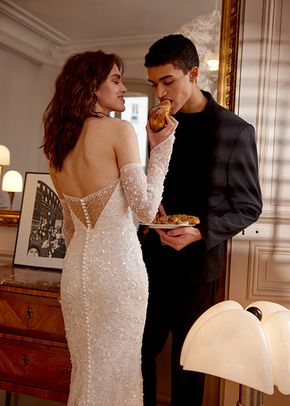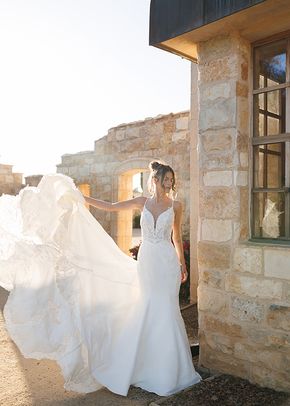When it comes to Weddings,
everyone's superstitious. Even if you're the kind of person who walks
under ladders on point of principle, or laughs their socks off when
friends touch wood, you can bet that, when your wedding day dawns, wild
horses couldn't stop you clutching something old and donning something
blue. And thats just for starters. We guarantee that you wouldn't
dream of seeing your fiance on the morning of the wedding. And will you
expect to be carried across the threshold? Of course you will!
But where do these old traditions come from?
Well, some can be traced back to Roman & Anglo Saxon times, some to
Victorian rhymes and others to folklore that has been passed down
through countless generations.
All of them are to do with bestowing good luck and fertility on the happy couple.
There are so many superstitions and traditions associated with Weddings
that its impossible to follow them all. Many have changed over time,
while others, thankfully, are very watered-down versions of old customs.
The
tradition of tying old shoes to the back of the Couple's car, for
example, stems from Tudor times when guests would throw shoes at the
Bride & Groom, with great luck being bestowed on them if they or
their carriage were hit!
In Anglo Saxon times the Bride was
symbolically struck with a shoe by her Groom to establish his authority.
Brides would then throw shoes at their bridesmaids to see who would
marry next.
Something Old, Something New, Something Borrowed, Something Blue and a Silver Sixpence in her Shoe
This rhyme originated in Victorian times. 'Something Old' signifies that the Couple's friends will stay with them. In one version of the tradition the 'Something Old' was an old garter which was given to the bride by a happily married woman so that the new bride would also enjoy a happy marriage. 'Something New' looks to the future for health, happiness and success.
'Something Borrowed' is an opportunity for the Bride's family to give her something as a token of their love (it must be returned to ensure Good Luck), and 'Something Blue' is thought lucky because Blue represents fidelity and constancy. The custom began in ancient Israel where brides wore a blue ribbon in their hair to symbolise their fidelity. A sixpence was placed in the shoe to bring the couple wealth in their married life. Some brides still place a penny in their shoe during the marriage ceremony.
Flower Power
Flowers have always been a big feature at Weddings. The Groom is supposed to wear a flower that appears in the Bridal Bouquet in his button-hole. This stems from the Medieval tradition of a Knight wearing his Lady's colours, as a declaration of his love. Each flower has its own meaning and can display a special message. Orange Blossom, for instance, signifies chastity, purity and loveliness, while red chrysanthemum means " I love you "
The Time & The Place
Sunday used to be the most
popular wedding day, as it was the one day most people were free from
work. Puritans in the Seventeenth Century put a stop to this, however,
believing it was improper to be festive on the Sabbath. Today,
Saturdays are the busiest, despite the rhyme
Monday for health, Tuesday for wealth, Wednesday best of all,
Thursday for losses, Friday for crosses, Saturday for no luck at all
As for the time of year, the
saying 'Marry in the month of May, and you'll live to rue the day'
dates back to Pagan times. May, the start of summer, was dedicated to
outdoor orgies (ie the summer festival Beltane), hardly the best way to
begin married life! Queen Victoria is said to have banned her children
from marrying in May, and Nineteenth Century Vicars were rushed of their
feet on April 30th because Brides refused to marry during May. The sun
has always been associated with sexual stimulation and, therefore
future fertility. In Scotland it was traditional for the Bride to 'walk
with the sun', proceeding from east to west on the south side of the
church and then circling the Church three times 'sunwise' for good luck.
Married when the year is new, he'll be loving, kind & true,
When February birds do mate, You wed nor dread your fate.
If you wed when March winds blow, joy and sorrow both you'll know.
Marry in April when you can, Joy for Maiden & for Man.
Marry in the month of May, and you'll surely rue the day.
Marry when June roses grow, over land and sea you'll go.
Those who in July do wed, must labour for their daily bred.
Whoever wed in August be, many a change is sure to see
Marry in September's shrine, your living will be rich and fine.
If in October you do marry, love will come but riches tarry.
If you wed in bleak November, only joys will come, remember.
When December snows fall fast, marry and true love will last.
Food for Thought
The Wedding Cake was originally lots of little wheat cakes that were broken over the Bride's head to bestow good luck and fertility. Today's three tier Wedding Cake is based on the unusual shape of the spire of Saint Bride's Church in London. Traditionally the newly-weds should make the first cut to signify sharing their life. Every guest than eats a crumb to ensure good luck. And sleeping with a piece under her pillow is said to make a single woman dream of her future husband. The giving of almond favours is connected with the motto: 'A gift of five almonds represents health, wealth, long life, fertility and happiness' The throwing of confetti, meanwhile is an ancient fertility rite. Handfuls of grain or nuts were traditionally thrown because they are 'life-giving' seeds. In some European countries, eggs are thrown instead.
Get me to the Church..
Walking is thought to be
the best way of getting to Church, as there's more chance of spotting
lucky omens. Seeing a rainbow, having the sun shine on the Bride and
meeting a black cat or a chimney sweep are all lucky.
Bad omens
include seeing a pig, hare or lizard running across the road, or
spotting an open grave. Make sure the road is clear on Monks or Nuns
too, they fortell barreness and a life dependant on charity.
Coming
home from Church can be equally hazardous. Tradition dictates the new
wife must enter her home by the main door and, to avoid bad luck, must
never trip or fall - hence the custom that a bride should be carried
over the threshold.
Dressing Up
Until the Nineteen Hundreds
Brides hardly ever bought a special Wedding Dress, opting for their best
outfit instead. Green was always avoided, as it was though to be
unlucky. To say a girl 'had a green gown' also implied that she was of
loose morals, because her dress would be grass-stained due to rolling
around in the fields! Hence 'Marry in Green, ashamed to be seen'.
White Dresses were made popular by Queen Victoria, who broke the
tradition of royals marrying in Silver. Symbolising purity and
virginity, white was also thought to ward off evil spirits. Other
traditions are that the bride should never make her own dress, that the
final stitch should not be completed until she is departing for the
Church and that she should never try on the entire outfit before the
day. This was because it was felt dangerous for the Bride to count her
chickens. For the same reason, a Bride should never practise signing
her new name until it is legally hers, and wedding linen was marked with
the Brides maiden rather than married initials. The tradition of
Bridesmaids is evolved from the custom of surrounding the Bride with
other richly dressed women, in order to confuse evil spirits.
Married in White, you have chosen right
Married in Grey, you will go far away,
Married in Black, you will wish yourself back,
Married in Red, you will wish yourself dead,
Married in Green, ashamed to be seen,
Married in Blue, you will always be true,
Married in Pearl, you will live in a whirl,
Married in Yellow, ashamed of your fellow,
Married in Brown, you will live in the town,
Married in Pink, you spirit will sink.

















